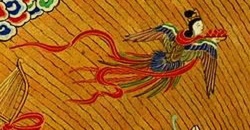Kalaviṅka
kalaviṅka (迦陵頻伽). A bird with a melodious voice, found in the Himalayas. It has beautiful black plumage and a red beak. It starts singing in the eggshell before it is hatched. Its beautiful voice surpasses that of humans, gods, kiṁnaras, and other birds, and is likened to the wondrous tones of Buddhas and holy Bodhisattvas.
Karyōbinga (迦陵頻迦(かりょうびんが)?) is the Japanese name for a fantastical immortal creature in Buddhism, possessed of a human head and a bird's torso, with long flowing tail. The name is the transliteration from the Sanskrit kalavinka (kalaviṅka कलविङ्क (?)).
The karyōbinga is said to dwell in Buddhist paradise (gokuraku-jōdo, nirvana), and reputed to preach the Buddhist scripture with its fine voice. It is said to sing while still unhatched within its eggshell. Its voice is a descriptor of the Buddha's voice. In Japanese text, it is sometimes written not phonetically, but under translated names myōonchō (妙音鳥 "exquisite sounding bird"?), kōonchō (好音鳥 "goodly sounding bird"?) among other rendered names.
In Chinese mural art, it is portrayed as a human-headed, bird-bodied being (i.e. armless?) , but in Japanese Buddhist art, it has been portrayed with an upper torso of a winged boddhisatva (i.e., having hands and arms), with a birdlike lower extremity. In the murals of Dunhuang (敦煌) they appear as figures both dancing and playing music.
Depictions
A well-known example is the pair of karyōbinga carved in openwork (sukashibori) onto a Buddhist hanging ornament called the keman, used in the golden hall of Chūson-ji temple in Iwate Prefecture. The karyōbinga from this ornament was commemorated on a 120-yen definitive stamp issued Nov. 1, 1962. The pose and general appearance on this piece is similar to the ones seen on the octagonal pedestal of the same temple (pictured right).
In another keman from the Tokugawa period (see keman page), the creatures stand more bipedally erect and hence more humanlike.
List of portrayals in traditional art
In the ancient courtly dance performance Gagaku - karyobin (迦陵頻?) is the name of dance expressive of the karyōbinga, and is danced in pair with the kochō (胡蝶?), a dance of butterfly motif. The paired dancing is called tsugai-mai (番舞?).</ref> A karyōbinga painting by the brushstrokes of Hasegawa Tōhaku resides in Daitoku-ji (Kyoto), inside the Kinmōkaku (金毛閣?) erected by tea-master Sen no Rikyū. Painted on the ceiling of Tōfuku-ji's Sanmon gate (Kyoto). Painted on the ceiling of Myōshin-ji's Sanmon gate (Kyoto), normally not open to public. The Mizusawa Kannon(ja) at 214 Mizusawa, in the former city of Ikaho, Gunma, Main Hall, front right ceiling, painting of a heavenly woman with eagle-like talons, anonymous. Kawakami Sadayakko (Sada Yacco), billed as the first overseas Japanese actress, late in her life, built a villa located at Unumahōshakujichō, Kagamihara, Gifu. The villa was christened Banshōen (萬松園?) by Itō Hirobumi, and the room with the Buddhist altar has a ceiling painting of karyōbinga, which may be peered from outside (but access to premises only on Tuesday mornings).
